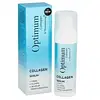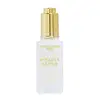What's inside
What's inside
 Key Ingredients
Key Ingredients

 Benefits
Benefits

 Concerns
Concerns

 Ingredients Side-by-side
Ingredients Side-by-side

Water
Skin ConditioningGlycerin
HumectantNiacinamide
SmoothingCaprylic/Capric Triglyceride
MaskingBetaine
HumectantDecyl Oleate
EmollientIsoamyl Laurate
EmollientCaprylyl Glycol
EmollientCarbomer
Emulsion StabilisingTriethyl Citrate
Masking3-O-Ethyl Ascorbic Acid
Skin ConditioningSodium Polyglutamate
HumectantBenzoic Acid
MaskingSodium Hydroxide
BufferingParfum
MaskingTocopheryl Acetate
AntioxidantAcrylates/C10-30 Alkyl Acrylate Crosspolymer
Emulsion StabilisingGlycine Soja Oil
EmollientDisodium EDTA
Sodium Hyaluronate
HumectantCollagen Amino Acids
MoisturisingTocopherol
AntioxidantHydroxypropyl Cyclodextrin
MaskingLeuconostoc/Radish Root Ferment Filtrate
AntimicrobialBeta-Sitosterol
Emulsion StabilisingHydroxycitronellal
PerfumingSqualene
EmollientLimonene
PerfumingAlpha-Isomethyl Ionone
PerfumingCitronellol
PerfumingEugenol
PerfumingPalmitoyl Tripeptide-38
Skin ConditioningHydrogenated Palm Glycerides Citrate
EmollientWater, Glycerin, Niacinamide, Caprylic/Capric Triglyceride, Betaine, Decyl Oleate, Isoamyl Laurate, Caprylyl Glycol, Carbomer, Triethyl Citrate, 3-O-Ethyl Ascorbic Acid, Sodium Polyglutamate, Benzoic Acid, Sodium Hydroxide, Parfum, Tocopheryl Acetate, Acrylates/C10-30 Alkyl Acrylate Crosspolymer, Glycine Soja Oil, Disodium EDTA, Sodium Hyaluronate, Collagen Amino Acids, Tocopherol, Hydroxypropyl Cyclodextrin, Leuconostoc/Radish Root Ferment Filtrate, Beta-Sitosterol, Hydroxycitronellal, Squalene, Limonene, Alpha-Isomethyl Ionone, Citronellol, Eugenol, Palmitoyl Tripeptide-38, Hydrogenated Palm Glycerides Citrate
Water
Skin ConditioningGlycerin
HumectantIsohexadecane
EmollientNiacinamide
SmoothingIsononyl Isononanoate
EmollientButyrospermum Parkii Butter
Skin ConditioningButylene Glycol
HumectantPolysorbate 20
EmulsifyingPhenoxyethanol
PreservativeCarbomer
Emulsion StabilisingDimethyl Isosorbide
SolventHaematococcus Pluvialis Extract
AntioxidantYeast Ferment Extract
Skin ConditioningArginine Hcl
Skin ConditioningSodium Hydroxide
BufferingEthylhexylglycerin
Skin ConditioningDisodium EDTA
Hydroxyethylcellulose
Emulsion Stabilising3-O-Ethyl Ascorbic Acid
Skin ConditioningTocopheryl Acetate
AntioxidantParfum
MaskingPlumeria Alba Flower Extract
Skin ConditioningSodium Polyglutamate
HumectantRosa Centifolia Flower Extract
AstringentSodium Hyaluronate
HumectantPentylene Glycol
Skin ConditioningMagnesium Aspartate
Skin ConditioningZinc Gluconate
Skin ConditioningIpomoea Batatas Tuber Extract
Antioxidant1,2-Hexanediol
Skin ConditioningHelianthus Annuus Seed Oil
EmollientLactobacillus Ferment
Skin ConditioningMyrothamnus Flabellifolia Leaf/Stem Extract
HumectantPotassium Sorbate
PreservativeBiosaccharide Gum-4
Skin ConditioningCopper Gluconate
Skin ConditioningSodium Benzoate
MaskingLeuconostoc/Radish Root Ferment Filtrate
AntimicrobialSorbic Acid
PreservativeAcetyl Tetrapeptide-11
Skin ConditioningAcetyl Tetrapeptide-9
Skin ConditioningDaucus Carota Sativa Root Extract
Skin ConditioningDaucus Carota Sativa Seed Oil
EmollientBeta-Carotene
Skin ConditioningAscorbyl Palmitate
AntioxidantBenzyl Alcohol
PerfumingGeraniol
PerfumingCitronellol
PerfumingLinalool
PerfumingWater, Glycerin, Isohexadecane, Niacinamide, Isononyl Isononanoate, Butyrospermum Parkii Butter, Butylene Glycol, Polysorbate 20, Phenoxyethanol, Carbomer, Dimethyl Isosorbide, Haematococcus Pluvialis Extract, Yeast Ferment Extract, Arginine Hcl, Sodium Hydroxide, Ethylhexylglycerin, Disodium EDTA, Hydroxyethylcellulose, 3-O-Ethyl Ascorbic Acid, Tocopheryl Acetate, Parfum, Plumeria Alba Flower Extract, Sodium Polyglutamate, Rosa Centifolia Flower Extract, Sodium Hyaluronate, Pentylene Glycol, Magnesium Aspartate, Zinc Gluconate, Ipomoea Batatas Tuber Extract, 1,2-Hexanediol, Helianthus Annuus Seed Oil, Lactobacillus Ferment, Myrothamnus Flabellifolia Leaf/Stem Extract, Potassium Sorbate, Biosaccharide Gum-4, Copper Gluconate, Sodium Benzoate, Leuconostoc/Radish Root Ferment Filtrate, Sorbic Acid, Acetyl Tetrapeptide-11, Acetyl Tetrapeptide-9, Daucus Carota Sativa Root Extract, Daucus Carota Sativa Seed Oil, Beta-Carotene, Ascorbyl Palmitate, Benzyl Alcohol, Geraniol, Citronellol, Linalool
Ingredients Explained
These ingredients are found in both products.
Ingredients higher up in an ingredient list are typically present in a larger amount.
You might know this ingredient as Ethyl Ascorbic Acid, a more stable version of ascorbic acid.
Like other types of vitamin C, this ingredient has many benefits including reducing wrinkles, skin soothing, dark spot fading, and fighting against free radicals.
3-O-Ethyl Ascorbic Acid interferes with the process of skin darkening, helping to reduce hyperpigmentation. It also encourages the skin to produce more collagen.
Once applied, 3-O-Ethyl Ascorbic Acid is converted to Vitamin C deeper in the skin's layers. This process is slow but makes this ingredient more tolerable for skin.
The optimum pH range for this ingredient is 4 - 5.5
Learn more about 3-O-Ethyl Ascorbic AcidCarbomer is a polymer of acrylic acid. Its main role is to create a gel consistency.
A high amount of carbomer can cause pilling or balling up of products. Don't worry, most products contain 1% or less of carbomer.
Citronellol is used to add fragrance/parfum to a product. It is often derived from plants such as roses. In fact, it can be found in many essential oils including geranium, lavender, neroli, and more. The scent of Citronellol is often described as "fresh, grassy, and citrus-like".
Since the Citronellol molecule is already unstable, Citronellol becomes irritating on the skin when exposed to air.
Citronellol is a modified terpene. Terpenes are unsaturated hydrocarbons found in plants. They make up the primary part of essential oils.
Citronellol is not able to be absorbed into deeper layers of the skin. It has low permeability,
Citronellol is also a natural insect repellent.
Learn more about CitronellolDisodium EDTA plays a role in making products more stable by aiding other preservatives.
It is a chelating agent, meaning it neutralizes metal ions that may be found in a product.
Disodium EDTA is a salt of edetic acid and is found to be safe in cosmetic ingredients.
Learn more about Disodium EDTAGlycerin is already naturally found in your skin. It helps moisturize and protect your skin.
A study from 2016 found glycerin to be more effective as a humectant than AHAs and hyaluronic acid.
As a humectant, it helps the skin stay hydrated by pulling moisture to your skin. The low molecular weight of glycerin allows it to pull moisture into the deeper layers of your skin.
Hydrated skin improves your skin barrier; Your skin barrier helps protect against irritants and bacteria.
Glycerin has also been found to have antimicrobial and antiviral properties. Due to these properties, glycerin is often used in wound and burn treatments.
In cosmetics, glycerin is usually derived from plants such as soybean or palm. However, it can also be sourced from animals, such as tallow or animal fat.
This ingredient is organic, colorless, odorless, and non-toxic.
Glycerin is the name for this ingredient in American English. British English uses Glycerol/Glycerine.
Learn more about GlycerinLeuconostoc/Radish Root Ferment Filtrate is a natural preservative. It comes from fermenting radish roots with a bacteria called leuconostoc.
Leuconostoc comes from lactic acid.
This ingredient has antimicrobial properties and helps prevent the growth of bacteria in a product.
Leuconostoc is used to make the traditional Korean side-dish, kimchi. It is also used to make sourdough bread (both incredibly yummy foods).
Learn more about Leuconostoc/Radish Root Ferment FiltrateNiacinamide is a multitasking form of vitamin B3 that strengthens the skin barrier, reduces pores and dark spots, regulates oil, and improves signs of aging.
And the best part? It's gentle and well-tolerated by most skin types, including sensitive and reactive skin.
You might have heard of "niacin flush", or the reddening of skin that causes itchiness. Niacinamide has not been found to cause this.
In very rare cases, some individuals may not be able to tolerate niacinamide at all or experience an allergic reaction to it.
If you are experiencing flaking, irritation, and dryness with this ingredient, be sure to double check all your products as this ingredient can be found in all categories of skincare.
When incorporating niacinamide into your routine, look out for concentration amounts. Typically, 5% niacinamide provides benefits such as fading dark spots. However, if you have sensitive skin, it is better to begin with a smaller concentration.
When you apply niacinamide to your skin, your body converts it into nicotinamide adenine dinucleotide (NAD). NAD is an essential coenzyme that is already found in your cells as "fuel" and powers countless biological processes.
In your skin, NAD helps repair cell damage, produce new healthy cells, support collagen production, strengthen the skin barrier, and fight environmental stressors (like UV and pollution).
Our natural NAD levels start to decline with age, leading to slower skin repair, visible aging, and a weaker skin barrier. By providing your skin niacinamide, you're recharging your skin's NAD levels. This leads to stronger, healthier, and younger looking skin.
Another name for vitamin B3 is nicotinamide. This vitamin is water-soluble and our bodies don't store it. We obtain Vitamin B3 from either food or skincare. Meat, fish, wheat, yeast, and leafy greens contain vitamin B3.
The type of niacinamide used in skincare is synthetically created.
Learn more about NiacinamideParfum is a catch-all term for an ingredient or more that is used to give a scent to products.
Also called "fragrance", this ingredient can be a blend of hundreds of chemicals or plant oils. This means every product with "fragrance" or "parfum" in the ingredients list is a different mixture.
For instance, Habanolide is a proprietary trade name for a specific aroma chemical. When used as a fragrance ingredient in cosmetics, most aroma chemicals fall under the broad labeling category of “FRAGRANCE” or “PARFUM” according to EU and US regulations.
The term 'parfum' or 'fragrance' is not regulated in many countries. In many cases, it is up to the brand to define this term.
For instance, many brands choose to label themselves as "fragrance-free" because they are not using synthetic fragrances. However, their products may still contain ingredients such as essential oils that are considered a fragrance by INCI standards.
One example is Calendula flower extract. Calendula is an essential oil that still imparts a scent or 'fragrance'.
Depending on the blend, the ingredients in the mixture can cause allergies and sensitivities on the skin. Some ingredients that are known EU allergens include linalool and citronellol.
Parfum can also be used to mask or cover an unpleasant scent.
The bottom line is: not all fragrances/parfum/ingredients are created equally. If you are worried about fragrances, we recommend taking a closer look at an ingredient. And of course, we always recommend speaking with a professional.
Learn more about ParfumSodium Hyaluronate is hyaluronic acid's salt form. It is commonly derived from the sodium salt of hyaluronic acid.
Like hyaluronic acid, it is great at holding water and acts as a humectant. This makes it a great skin hydrating ingredient.
Sodium Hyaluronate is naturally occurring in our bodies and is mostly found in eye fluid and joints.
These are some other common types of Hyaluronic Acid:
Learn more about Sodium HyaluronateSodium Hydroxide is also known as lye or caustic soda. It is used to adjust the pH of products; many ingredients require a specific pH to be effective.
In small amounts, sodium hydroxide is considered safe to use. However, large amounts may cause chemical burns due to its high alkaline.
Your skin has a natural pH and acid mantle. This acid mantle helps prevent harmful bacteria from breaking through. The acid mantle also helps keep your skin hydrated.
"Alkaline" refers to a high pH level. A low pH level would be considered acidic.
Learn more about Sodium HydroxideWe don't have a description for Sodium Polyglutamate yet.
Tocopheryl Acetate is AKA Vitamin E. It is an antioxidant and protects your skin from free radicals. Free radicals damage the skin by breaking down collagen.
One study found using Tocopheryl Acetate with Vitamin C decreased the number of sunburned cells.
Tocopheryl Acetate is commonly found in both skincare and dietary supplements.
Learn more about Tocopheryl AcetateWater. It's the most common cosmetic ingredient of all. You'll usually see it at the top of ingredient lists, meaning that it makes up the largest part of the product.
So why is it so popular? Water most often acts as a solvent - this means that it helps dissolve other ingredients into the formulation.
You'll also recognize water as that liquid we all need to stay alive. If you see this, drink a glass of water. Stay hydrated!
Learn more about Water